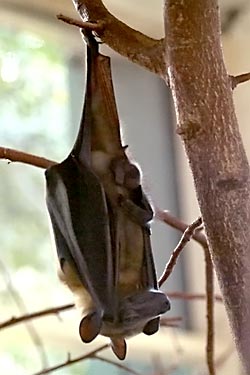Palm bat
| Palm bat | ||||||||||||
|---|---|---|---|---|---|---|---|---|---|---|---|---|

Palm bat ( Eidolon helvum ) |
||||||||||||
| Systematics | ||||||||||||
|
||||||||||||
| Scientific name | ||||||||||||
| Eidolon helvum | ||||||||||||
| ( Kerr , 1792) |

The Palm Fruit Bat ( Eidolon helvum ) is a mammal of the family of flying foxes (Pteropodidae). It is one of the most widespread and best-known fruit bats on the African continent.
The distribution area of the palm bat stretches from Senegal and Ethiopia to South Africa , and can also be found in the southwest of the Arabian Peninsula .
description
The fur of these animals is straw-colored on the top and brownish on the underside. The males have a reddish-colored, gland-rich spot on the throat and sides of the neck. The animals reach a head body length of 14 to 21 centimeters, as with most fruit bats, the tail is short (0.4 to 2 centimeters), the wingspan is up to 76 centimeters and they reach a weight of 230 to 350 grams.
Palm bats prefer to stay in forest areas where fruits , their main food, are available. They are also found in savannahs and dry areas as well as in mountains up to 2000 meters above sea level. During the day they sleep in large groups (often several thousand animals) mostly on trees, sometimes in caves and man-made shelters. At night they fly out to look for food, whereby they can cover distances of 30 kilometers in one night. Palm bats show a pronounced migratory behavior, depending on the rainy and dry seasons, they often visit other regions, thereby joining together to form large groups of up to a million individuals. Spread over the year, they can cover 2500 kilometers.
food
Palm bats feed mainly on fruits, including those of the borassus palms ( Borassus ), date palms , mangoes , Ceibas and other trees; but also flowers and nectar like those of the baobab trees . However, they do not consume whole fruits, but mainly suck out the juice. Through their eating habits, they play an important role in the pollination of some plants. In addition, the animals are considered to be important seed dispersers. A single colony of palm bats can transport up to 300,000 seeds in one night at distances of up to 95 km. The long transport routes and large quantities mean that seeds also reach areas that have already been deforested, whereby palm bats make an important ecological contribution.
Reproduction
Mating takes place between April and June, as is the case with many bats, implantation is delayed, so that although nine months pass between mating and birth, the embryo itself only grows four months in the uterus. Most births take place in February and March and are timed to fall during the rainy season, when the greatest food supply is available. At the time of birth, the females join together in nurseries, the fathers do not take part in the rearing. Usually one young is born, rarely two. The life expectancy of these animals is around 15 years, some animals live to be over 20 years old.
Palm bats and people
Since palm dogs live together in large groups and often invade orchards or gardens, they are considered a nuisance in some places and are hunted accordingly. The palm bat is hunted extensively in order to sell it as bushmeat . As a result, the stocks have declined noticeably within the last three generations, but the decimation is less than 30%. The IUCN therefore lists the palm bat in the early warning list ( near threatened ).
In Germany they are maintained in Berlin, Munich and Eberswalde.
Individual evidence
- ↑ Mariëlle L. van Toor, M. Teague O'Mara, Michael Abedi-Lartey, Martin Wikelski, Jakob Fahr and Dina KN Dechmann: Linking colony size with quantitative estimates of ecosystem services of African fruit bats. Current Biology 29 (7), 2019, p. PR237-R238, doi: 10.1016 / j.cub.2019.02.033
- ↑ Eidolon helvum in the endangered Red List species the IUCN 2012. Posted by: Mickleburgh, S., Hutson, AM, Bergmans, W., driving, J. & Racey, PA, 2008. Accessed November 12, 2012th
- ↑ [1] ZTL 16.6
literature
- Ronald M. Nowak: Walker's Mammals of the World. 6th edition. Johns Hopkins University Press, Baltimore 1999, ISBN 0-8018-5789-9 .
